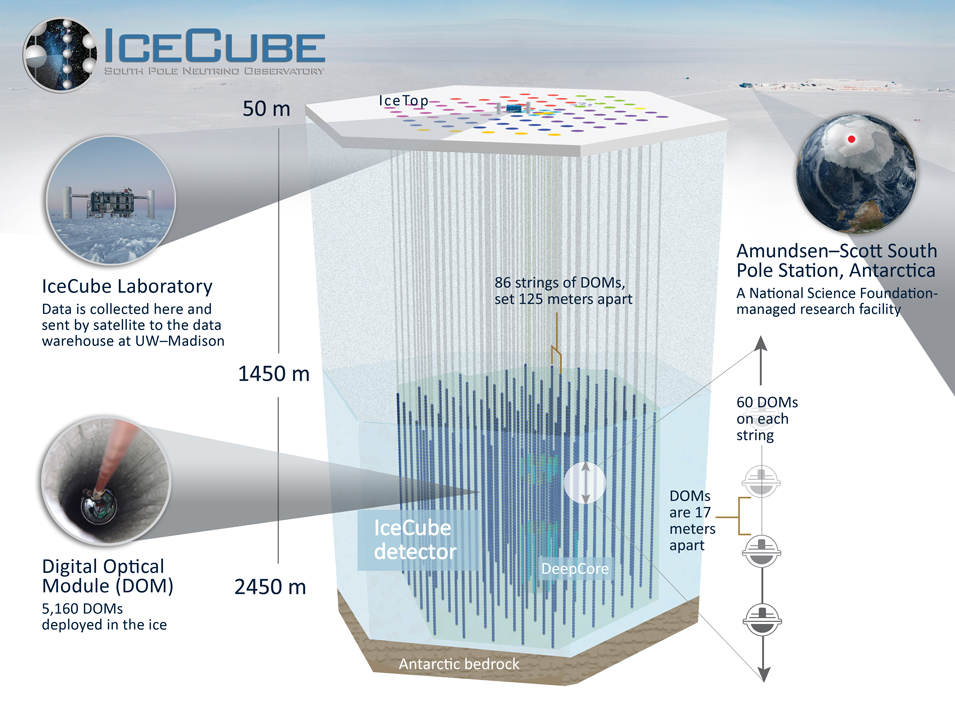
Unveiling the Mysteries of the Universe: IceCube Neutrino Tracks Reconstruction
IceCube Neutrino Observatory is a one cubic kilometer neutrino detector located in the primordial ice at the South Pole. Its main goal is the detection of astrophysical neutrinos (neutrinos originating from extraterrestrial sources), and identification of their sources. Recently, The IceCube Neutrino Observatory has provided scientists with an incredible opportunity to explore the secrets of the Universe and push the boundaries of human knowledge. An amazing adventure, driven by curiosity and determination, has led to remarkable discoveries, offering physicists a glimpse into the vast cosmic world beyond our own galaxy.
We would like to extend our heartfelt gratitude to the brilliant minds behind the IceCube Neutrino Observatory for providing the QuData team of scientists with the opportunity to participate in their groundbreaking research. Their work in understanding the Universe has helped our physicists delve into new frontiers of scientific exploration. We are thankful to the research organizers for the provided large dataset, without which we would not have been able to train complicated architectures and combine them into an ensemble.
Neutrinos, often called "ghost particles", are elusive subatomic particles that traverse the Universe at nearly the speed of light. They possess no electric charge and interact extremely weakly with matter, making them incredibly challenging to detect. However, their detection is of paramount importance as they can carry valuable information about distant cosmic events.
In this remarkable research, we were entrusted with the task of developing advanced algorithms to analyze data collected by the IceCube Neutrino Observatory. Situated deep beneath the Antarctic ice, the observatory is an awe-inspiring structure comprising thousands of sensors capable of capturing neutrino interactions. By meticulously studying these interactions, scientists aim to uncover the mysteries of astrophysical phenomena such as supernovae, black holes, and even the enigmatic dark matter.
The QuData team embarked on an exciting journey to study the massive amount of data collected by the observatory. Through countless hours of analysis, we meticulously examined the intricate patterns, seeking the telltale signatures of neutrino interactions. With the help of powerful machine learning techniques, we unleashed the potential of these algorithms to identify and classify these elusive particles amidst the vast cosmic background noise.

Our approach to neutrino track restoration was to use an ensemble of Transformer models and modified GraphNet models. You can dive into the extensive details of our accomplished research by reading the comprehensive report, which provides a thorough overview of the research process, methodology, and findings. In the report, we discuss the challenges encountered and the innovative approaches employed to overcome them. To explore further, you can also access the source code of our solutions on GitHub, enabling you to delve into the technical aspects of our work and even contribute to the ongoing development.
Our joint research opens up new avenues for studying elusive particles like dark matter, which accounts for a significant portion of the Universe’s mass but has thus far eluded direct observation. By harnessing the power of IceCube Neutrino Observatory’s data and advanced machine learning algorithms, we can delve deeper into the properties of dark matter and potentially uncover its true nature. These findings have a profound impact, opening doors to future breakthroughs in space science and bringing us closer to unraveling the mysteries of the Universe.
Iryna Tkachenko, marketing manager
